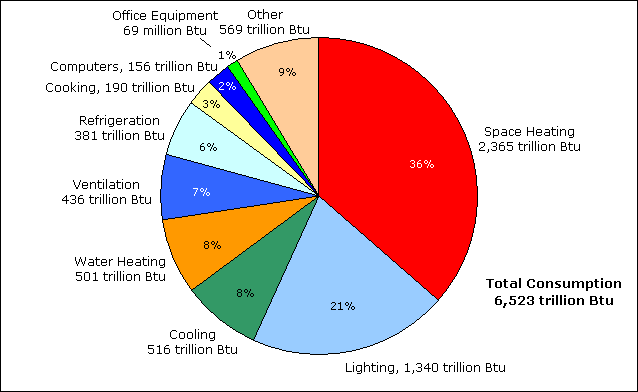We live in one of the most connected countries in the world, using energy for multiple functions each and every day, especially in commercial buildings. But how does that energy use get spread around? For what functions do we use the most energy? The least? If you are flthat your energy bills are higher than you expected, why not look into using a website like Simply Switch to help you save money on your energy bills and also switch provider to find the best deals that won’t be found anywhere else on gas and electricity.
After Lindsay Wilson of Shrink That Footprint published a post on how American and EU households consume energy, we wanted to look into how the commercial sector uses energy in more detail.
According to the U.S. Department of Energy’s Energy Data Book, buildings represent 41.1% of national primary energy consumption (2010). Fairly evenly split with residential, commercial buildings represent 18.6% of national energy consumption. What’s more, U.S. buildings in total represent 40% of our carbon dioxide emissions. Commercial buildings represent 18% of total carbon dioxide emissions.
So what adds up to all that commercial energy use?
More than half of commercial building energy consumption goes to space heating and lighting (EIA). Office equipment and computers clock in with just 3% of energy use (1% and 2% respectively).
So how do you determine how much energy you and your commercial building use? And where you use it?
This is actually something we’re tackling as a company this year as part of the 2013 RCGA St. Louis Green Business Challenge. So we thought we’d share that list of challenge ideas for assessing your own energy use, and even how to cut it down.
1. Calculate your average energy use at your building site (electricity and natural gas) over the last 12 months (this is also something that we look at when we evaluate buildings for solar installations)
2. Calculate a carbon footprint/greenhouse gas baseline from your energy audit information.
3. Conduct a lighting audit.
4. Eliminate incandescent lightbulbs. This can be done as lightbulbs burn out, or all at once, but replacing incandescents with compact fluorescent bulbs (CFLs) can cut down on energy used for lighting. If you’re using fluorescent bulbs, you may also need light covers. These are also very easy to install and can prevent staff from getting headaches and migraines.
5. Install lighting sensors. Using sensors to make sure lights are turned off in kitchens, restrooms, offices, etc. when vacant – and/or daylight sensors, to turn off or dim lights in favor of ample daylight – can help cut down on energy use as well.
6. (Speaking of daylighting), Establish a daylighting policy. This works better for some than others, but for those blessed with an abundance of natural light, very often artificial light isn’t necessary.
7. Conduct an equipment audit, recording a list of all office appliances and their energy usage and consumption. Create a policy to require all new equipment to meet ENERGY STAR rating standards.
8. Change computer settings to go into sleep mode after a long period of non-use, and encourage employees to turn off computers when leaving to go home.
9. Evaluate your HVAC system. Does retrofitting make sense? Establish a plan to increase HVAC efficiency. Alternatively, reach out to Tulsa HVAC contractors and have the HVAC system reviewed to ensure it’s working efficiently.
10. Evaluate your commercial building for onsite renewable energy, such as solar. Generating your own clean electricity offsets your energy use as well as carbon dioxide emissions. You may also want to consider energy-saving solutions like the tinting of your office’s windows. If you’re looking for a company that does commercial window tinting all over Los Angeles then it might be worth getting in touch with Campbell Window Film to see how they can help. Not only can this help to reduce your energy usage but can also provide your workers with additional privacy from the outside world.
11. Establish an energy reduction plan of at least 10%.
What do you think? Already know the status of your commercial energy use, and what functions you use the most energy for? Share with us, and include your ideas to cut down energy use and costs.
